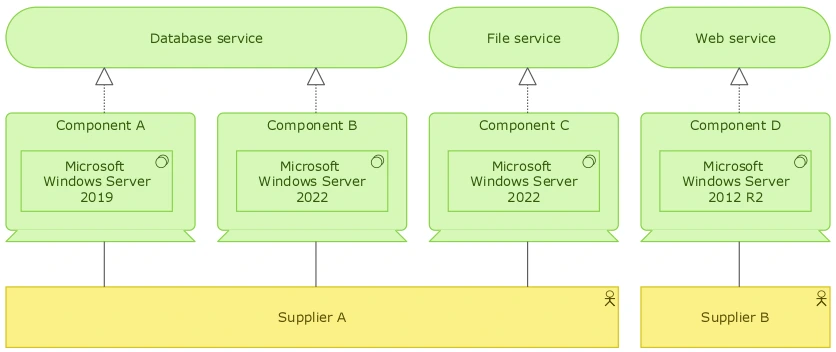A Technology Portfolio Catalog is designed to identify and track all technology components in use within the organization. Think, for example, about hardware (devices) and infrastructure software (system software). In addition, an agreed-upon technology portfolio supports the lifecycle management of technology products and releases. The technology components collected in a Technology Portfolio Catalog can also be used to define technology standards.
Definition
The TOGAF Standard provides two definitions of what is meant by a technology component.
1. A technology building block. A generic infrastructure technology that supports and enables application or data components (directly or indirectly) by providing technology services.
2. An encapsulation of technology infrastructure that represents a class of technology product or specific technology product1.
Applying the method
Creating a Technology Portfolio Catalog starts with making an appointment with the Configuration Management Database (CMDB) administrator. This person will most likely have a (reasonably) up-to-date record of all the server systems (devices) used in the organization. Firstly, ask for the list of technology components and document them in the Architecture Repository. Lastly, complete the components with information such as operating system software, version numbers, vendors, and the purpose of the technology component.
If a CMDB administrator is not available, it is possible to go into the server room in person, accompanied, of course, by someone with appropriate access privileges. The inventory of devices is then done by hand. Does the organization use outsourced services? In the event that it does, it is a good idea to find out who the contacts are at the vendors, based on existing support contracts. Furthermore, find out what agreements have been made with the suppliers and obtain information about the technology components for which they provide services to the organization.
In case a CMDB exists within the organization, it is and will remain the source for the primary collection of technology components. As a result, an export of the information contained in the CMDB can be performed a few times a year. The Architecture Repository can then be updated based on the exported data.
Gathering information
Some key questions that can be asked to arrive at a Technology Portfolio Map are:
- Is there a list of technology components in use?
- Is a Configuration Management Database (CMDB) in use?
- What is the purpose and role of the technology component?
- What off-the-shelf technology components are used?
- Is it a physical device or is it virtual?
- Are there any special or notable technology components in use?
- Are there any contracts available for review regarding the purchased technology component?
- Is the component within the walls of the organization (is it owned by the organization)?
- Is the technology component purchased as a service from a vendor?
Additional and more detailed questions (what operating system is running on the device, what version is being used, etc.) can be asked after the main questions have been answered.

Graphical represetation
The Technology Portfolio Catalog can also be visualized using a diagram.

The choice between a catalog and a diagram is usually a matter of personal preference. A catalog is preferred when the amount of additional information exceeds two columns (from the Technology Portfolio Catalog) of additional information. The more features that are visualized in a diagram, the more cluttered the diagram becomes.
More information
For additional information about creating a Technology Portfolio Catalog, please refer to Chapter 8, Section 8.2.1.5, of my book Getting Started with Enterprise Architecture.
Back to
- The Open Group, The TOGAF® Standard, 10th Edition, Introduction and Core Concepts. ’s-Hertogenbosch: Van Haren Publishing, 2022. ↩︎
